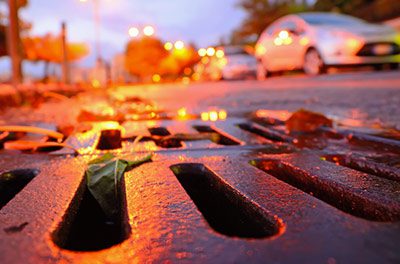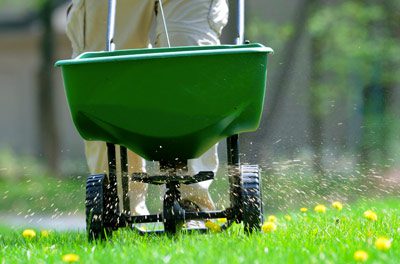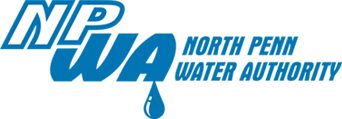Watershed
OUR WATER
What is a watershed?
A watershed is an area of land from which all the water drains or runs downhill to the same location such as a stream, pond, lake, river, wetland or estuary. Watersheds can be large such as the Mississippi River drainage basin or a small lake such as Lake Galena that serves as North Penn Water Authority’s 1 billion gallon reservoir and the surface source of our drinking water.
Everyone lives in a watershed so it is important to realize everything that is done on the land can impact the water within a watershed. The land use in a watershed affects the type of materials, such as sediment, nutrients and other pollutants that will wash from those areas and potentially have a negative impact on the watershed. Water pollution can occur and affect a watershed.
There are two sources of water pollution: point source and nonpoint source. Point source is pollution that flows from pipes or specific points, such as discharge from an industrial plant, sewage treatment plant, or storm water drain. Nonpoint source pollution is not the result of direct discharge from a specific point or source. Some examples of nonpoint source pollution include runoff from excessive usage of pesticides and fertilizers on residential lawns and gardens, agricultural fields, and golf courses. Soil erosion from construction or logging sites, along with oil, grease and other fluids from vehicles, nutrients from on-site septic systems and litter can be washed into surface waters during large storms.
Protecting Your Watershed

Properly maintain your car, reducing oil and other fluid leaks. Recycle the used oil. Call DEP at 1-800-346-4242 to locate the used oil collection site closest to you.
If possible, wash your car on your lawn, reducing amount of water to runoff, or use a commercial carwash that recycles the water.

Don’t pour toxic or hazardous substances down drains or toilets, on the ground, or in streams or down a storm drain. Storm drains may flow into a nearby creek or stream causing it to become polluted. Dispose of hazardous waste at hazardous waste drop off centers. Use natural and less-toxic household products whenever possible.
Regularly maintain and inspect septic systems.

Plant native vegetation, reducing the amount of pesticides, fertilizers and watering. For more information, contact the Pennsylvania Department of Conservation & Natural Resources for a copy of its brochure, “Landscaping with Native Plants”

Limit the use of pesticides and fertilizers on your lawn. Consider using natural organic fertilizers and natural alternatives for chemical pesticides. Avoid applying any fertilizers before a heavy rain is predicted.

Drain rooftop runoff into rain barrels, storing water to use later in gardens, yards or for house plants.

Properly dispose of pet waste, which can be high in bacteria and nutrients.
Other Tips
If you live close to a creek or stream, plant a riparian buffer zone. A riparian buffer zone is an area of trees, shrubs and bushes planted along the course of a river, creek or stream. The buffer zone reduces the amount of run-off and also removes some of the sediment and contaminants from the water before it enters the stream. Water quality is enhanced due to the shade from the trees reducing the temperature of the water, which improves aquatic life in the stream. The roots of the trees and shrubs also hold in the soil and prevent stream bank erosion.
For more information about riparian buffer zones, call the Authority for our brochure: “Riparian Buffers: Improving Community Water Quality.”
One of the best things you can do to protect your watershed is to be active in a local watershed association. Contact any of the following watershed associations to find out more information or to join:
Perkiomen Watershed Conservancy
1 Skippack Pike, Schwenksville, PA 19473-1800
Phone: (610) 287-9383 • E-mail: pwc@pvwatershed.org
www.perkiomenwatershed.org
Wissahickon Valley Watershed Association
12 Morris Road, Ambler, PA 19002-5499
Phone: 215-646-8866 • E-mail: wvwa@aol.com
www.wvwa.org
What is a watershed?
A watershed is an area of land from which all the water drains or runs downhill to the same location such as a stream, pond, lake, river, wetland or estuary. Watersheds can be large such as the Mississippi River drainage basin or a small lake such as Lake Galena that serves as North Penn Water Authority’s 1 billion gallon reservoir and the surface source of our drinking water.
Everyone lives in a watershed so it is important to realize everything that is done on the land can impact the water within a watershed. The land use in a watershed affects the type of materials, such as sediment, nutrients and other pollutants that will wash from those areas and potentially have a negative impact on the watershed. Water pollution can occur and affect a watershed.
There are two sources of water pollution: point source and nonpoint source. Point source is pollution that flows from pipes or specific points, such as discharge from an industrial plant, sewage treatment plant, or storm water drain. Nonpoint source pollution is not the result of direct discharge from a specific point or source. Some examples of nonpoint source pollution include runoff from excessive usage of pesticides and fertilizers on residential lawns and gardens, agricultural fields, and golf courses. Soil erosion from construction or logging sites, along with oil, grease and other fluids from vehicles, nutrients from on-site septic systems and litter can be washed into surface waters during large storms.
Protecting Your Watershed

Properly maintain your car, reducing oil and other fluid leaks. Recycle the used oil. Call DEP at 1-800-346-4242 to locate the used oil collection site closest to you.
If possible, wash your car on your lawn, reducing amount of water to runoff, or use a commercial carwash that recycles the water.

Don’t pour toxic or hazardous substances down drains or toilets, on the ground, or in streams or down a storm drain. Storm drains may flow into a nearby creek or stream causing it to become polluted. Dispose of hazardous waste at hazardous waste drop off centers. Use natural and less-toxic household products whenever possible.
Regularly maintain and inspect septic systems.

Plant native vegetation, reducing the amount of pesticides, fertilizers and watering. For more information, contact the Pennsylvania Department of Conservation & Natural Resources for a copy of its brochure, “Landscaping with Native Plants”

Limit the use of pesticides and fertilizers on your lawn. Consider using natural organic fertilizers and natural alternatives for chemical pesticides. Avoid applying any fertilizers before a heavy rain is predicted.

Drain rooftop runoff into rain barrels, storing water to use later in gardens, yards or for house plants.

Properly dispose of pet waste, which can be high in bacteria and nutrients.
Other Tips
If you live close to a creek or stream, plant a riparian buffer zone. A riparian buffer zone is an area of trees, shrubs and bushes planted along the course of a river, creek or stream. The buffer zone reduces the amount of run-off and also removes some of the sediment and contaminants from the water before it enters the stream. Water quality is enhanced due to the shade from the trees reducing the temperature of the water, which improves aquatic life in the stream. The roots of the trees and shrubs also hold in the soil and prevent stream bank erosion.
For more information about riparian buffer zones, call the Authority for our brochure: “Riparian Buffers: Improving Community Water Quality.”
One of the best things you can do to protect your watershed is to be active in a local watershed association. Contact any of the following watershed associations to find out more information or to join:
Perkiomen Watershed Conservancy
1 Skippack Pike, Schwenksville, PA 19473-1800
Phone: (610) 287-9383 • E-mail: pwc@pvwatershed.org
www.perkiomenwatershed.org
Wissahickon Valley Watershed Association
12 Morris Road, Ambler, PA 19002-5499
Phone: 215-646-8866 • E-mail: wvwa@aol.com
www.wvwa.org

Sitemap
Contact Info
Copyright © 2022 North Penn Water Authority • Site: BCG • Privacy Policy
